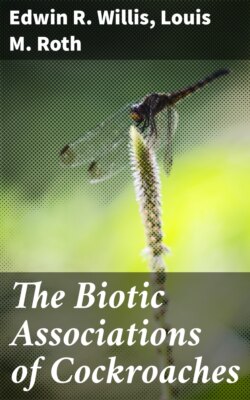Читать книгу The Biotic Associations of Cockroaches - Edwin R. Willis - Страница 171
На сайте Литреса книга снята с продажи.
ОглавлениеFlorida.—Series of specimens captured on Long Key under dead petioles of coconut palm on moist ground at edges of pools of brackish water. Specimens from Key West were in dry dead grass under boards (Rehn and Hebard, 1912). Nymphs frequent under bark on decaying pine logs in pine woods; occasional in leaf mold in heavy junglelike scrub (Rehn and Hebard, 1914). In water-soaked leaves in heavy red-mangrove swamp (Hebard, 1915). Under dead petioles of coconut palm on sandy soil in grapefruit grove (Hebard, 1916a). Numerous at bases of tufts of coarse grass growing just back of sea beach (Blatchley, 1920). Friauf (1953) found this species in leaf duff, leaf mold, debris, or decaying wood in these habitats: Dry, ruderal grassland (occasional), scrub (infrequent), sandhills (infrequent), mesic hammock (infrequent), pond margin (occasional), longleaf-pine flatwoods (occasional), and low hammock (infrequent). On bare soil or bare sand under vegetation in these habitats: Longleaf-pine flatwoods (occasional) and slash-pine flatwoods (occasional). Dominant in the spartina marsh habitat in the grass stratum and duff around clumps. Frequent in the saw-grass marsh habitat in the grass stratum and, during the dry season, in decaying vegetation on the marsh floor.
